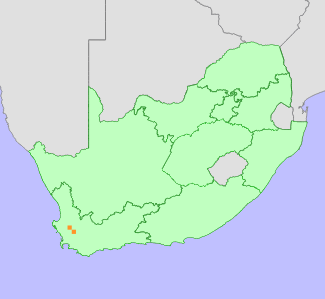|
Scientific Name | Protea mucronifolia Salisb. |
Higher Classification | Dicotyledons |
Family | PROTEACEAE |
Common Names | Dagger-leaf Sugarbush (e) |
National Status |
Status and Criteria | Endangered B1ab(iii,v)+2ab(iii,v); C2a(ii) |
Assessment Date | 2020/06/11 |
Assessor(s) | A.G. Rebelo, D. Raimondo & L. von Staden |
Justification | Protea mucronifolia is a restricted lowland fynbos species from the Western Cape Province of South Africa. It has an extent of occurrence (EOO) of 42 km² and an area of occupancy (AOO) of 32 km². Over 90% of this species' habitat has been lost to crop cultivation and only two subpopulations at three threat defined locations remain. A total of 95% of the population occurs at one location which has recently come under protection. This subpopulation is stable however the second subpopulation is experiencing severe and ongoing habitat degradation. This species therefore qualifies as Endangered under criteria B and C. |
Distribution |
Endemism | South African endemic |
Provincial distribution | Western Cape |
Range | This species is known from Hermon to Saron, in the Western Cape Province of South Africa. |
Habitat and Ecology |
Major system | Terrestrial |
Major habitats | Swartland Alluvium Fynbos |
Description | It grows in gravelly alluvium flats, 80 m. Mature individuals are killed by fires, and only seeds survive. Wind-dispersed seeds are stored in fire-resistant inflorescences, and released after fires. It is pollinated by insects. |
Threats |
| Over 90% of this species' former habitat has been lost to crop cultivation for cereals. The majority of this habitat transformation took place between 1945 and 1970. Only two subpopulations remain, the largest of these is at Elandsberg Private Nature Reserve, this site is well managed and was the first Biodiversity Stewardship Contract Nature Reserve to be declared in South Africa in 2005. The habitat at this location is connected with continuous fynbos mountain vegetation and hence burns in natural fire return intervals (with the majority of the population being burnt in 1999 and again in 2012). The second subpopulation at Renostervlei farm is small and experiencing ongoing severe habitat degradation as a result of too frequent fires, livestock overgrazing and competition from invasive alien woody plants. |
Population |
By 1985 the 20 km long former range of this species had been reduced to two subpopulations; one of between 800 and 1000 plants occurs predominantly on the Elandsberg Contract Nature Reserve, with a few plants (less than 50) from the same population occurring on the adjacent Voelvlei Nature Reserve. A second small subpopulation occurs on Renostervlei. The Elandsberg-Voelvlei subpopulation is considered stable as it experiences natural fire cycles. The Renostervlei subpopulation that consists of fewer than 50 plants is experiencing ongoing decline due to rapid and severe degradation of its habitat. The overall population is thus currently declining.
|
Population trend | Decreasing |
Conservation |
| It occurs in the Elandskloof Private Nature Reserve. |
Assessment History |
Taxon assessed |
Status and Criteria |
Citation/Red List version | | Protea mucronifolia Salisb. | CR B1ab(i,ii,iii,iv,v)c(iv)+2ab(i,ii,iii,iv,v)c(iv) | Raimondo et al. (2009) | | Protea mucronifolia Salisb. | Vulnerable | Hilton-Taylor (1996) | | Protea mucronifolia Salisb. | Endangered | Hall et al. (1980) | |
Bibliography |
Goldblatt, P. and Manning, J.C. 2000. Cape Plants: A conspectus of the Cape Flora of South Africa. Strelitzia 9. National Botanical Institute, Cape Town.
Hall, A.V., De Winter, M., De Winter, B. and Van Oosterhout, S.A.M. 1980. Threatened plants of southern Africa. South African National Scienctific Programmes Report 45. CSIR, Pretoria.
Hilton-Taylor, C. 1996. Red data list of southern African plants. Strelitzia 4. South African National Botanical Institute, Pretoria.
Manning, J.C. and Goldblatt, P. 2012. Plants of the Greater Cape Floristic Region 1: The Core Cape Flora. Strelitzia 29. South African National Biodiversity Institute, Pretoria.
Raimondo, D., von Staden, L., Foden, W., Victor, J.E., Helme, N.A., Turner, R.C., Kamundi, D.A. and Manyama, P.A. 2009. Red List of South African Plants. Strelitzia 25. South African National Biodiversity Institute, Pretoria.
Rebelo, T. 2001. Sasol Proteas: A field guide to the proteas of southern Africa. (2nd ed.). Fernwood Press, Vlaeberg, Cape Town.
|
Citation |
| Rebelo, A.G., Raimondo, D. & von Staden, L. 2020. Protea mucronifolia Salisb. National Assessment: Red List of South African Plants version 2024.1. Accessed on 2025/12/02 |
 Comment on this assessment
Comment on this assessment

